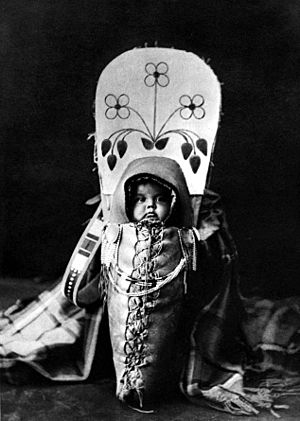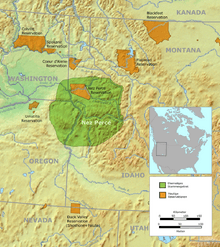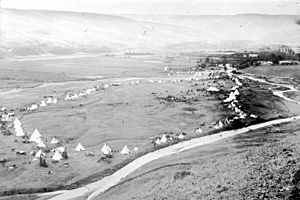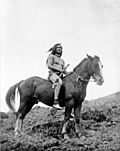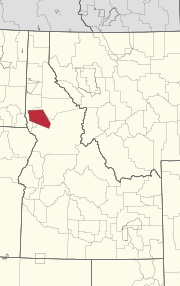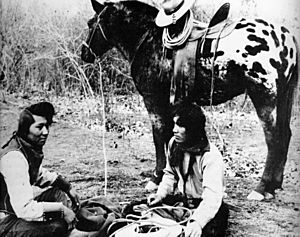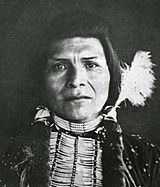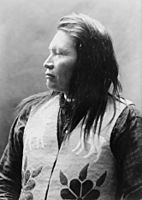Nez Perce facts for kids
| Nimiipuu | |
|---|---|
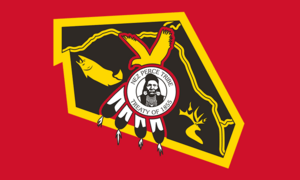 |
|
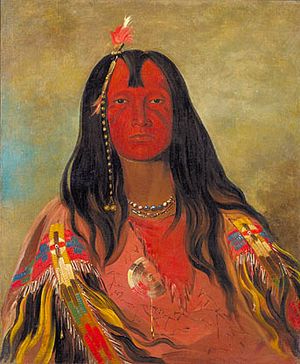
No Horn on His Head, a Nez Perce man painted by George Catlin
|
|
| Total population | |
| 3,500+ | |
| Regions with significant populations | |
| United States (Idaho) | |
| Languages | |
| English, Nimiipuu aka Nez Perce | |
| Religion | |
| Seven Drum (Walasat) & other | |
| Related ethnic groups | |
| other Sahaptin peoples |
The Nez Perce (pronounced "nez PURS") are an Indigenous people who have lived in the Pacific Northwest for at least 11,500 years. Their own name for themselves is Nimíipuu, which means "we, the people."
The Nimíipuu were a very important group on the Columbia Plateau. They became even more powerful after they started raising horses in the 1700s. They even bred a special horse called the Appaloosa. Before Europeans arrived, the Nimíipuu were skilled traders and warriors. They connected with many other Native American nations across a huge area, from Oregon to Montana and Idaho.
French explorers and trappers gave them the name "Nez Percé," which means "pierced nose." However, it was actually the nearby Chinook people who practiced nose piercing, not the Nimíipuu.
Over time, the Nez Perce lost much of their land due to treaties and wars. After the Nez Perce War of 1877, many were forced onto reservations. Despite these challenges, the Nez Perce have kept their unique culture and influence.
Today, the Nez Perce Tribe of Idaho is a federally recognized tribe. They manage their Native reservation in Idaho from their main office in Lapwai. They are one of five recognized tribes in Idaho. The tribe works hard to keep their culture strong. They own and run casinos, health clinics, a police force, and salmon fisheries. They also have a radio station and other programs that help them be self-sufficient.
Contents
Understanding the Nez Perce Name
The Nez Perce call themselves Nimíipuu, which means "The People" in their language. Their language is part of the Sahaptin family.
The name Nez Percé was given to them by French Canadian fur traders in the late 1700s. It means "pierced nose." English speakers later started using this name too. Since the late 1900s, the Nez Perce often use their own name, Niimíipuu.
When the Lewis and Clark Expedition met the tribe in 1805, their interpreters mistakenly called them Nez Perce. The explorers were very impressed by the Nez Perce people. They found them kind and helpful. The Nez Perce shared food and fresh horses with the tired explorers. They even took care of Lewis and Clark's horses while they continued their journey.
The Nez Perce Language
The Nez Perce language, also called Niimiipuutímt, is part of the Sahaptian language family. This family is connected to a larger group of languages called Plateau Penutian. Some people still speak their traditional language today.
Where the Nez Perce Lived
When Lewis and Clark explored the area (1804–1806), the Nez Perce territory was huge. It covered about 17 million acres (69,000 square kilometers). This land included parts of modern-day Washington, Oregon, Montana, and Idaho. It stretched around the Snake, Grande Ronde River, Salmon, and Clearwater rivers.
In 1800, the Nez Perce had over 70 permanent villages. Each village had between 30 and 200 people. They also had about 300 other sites, like temporary camps. In 1805, the Nez Perce were the largest tribe on the Columbia Plateau, with about 6,000 people. By the early 1900s, their population had dropped to about 1,800 due to diseases and conflicts. Today, the tribe has over 3,500 members.
Like other Plateau tribes, the Nez Perce moved between seasonal villages and camps. This allowed them to use different natural resources throughout the year. They traveled as far east as the Plains of Montana to hunt buffalo. They also went west to the Pacific Coast.
Friends and Foes
The Nez Perce had many friends and trading partners among nearby peoples. They also had some enemies. To their north lived the Coeur d’Alene and Spokane. To the west were the Cayuse and Umatilla. In the south lived the Northern Paiute and Bannock-Northern Shoshone. To the east were the Bitterroot Salish.
On the Plains, their main enemies were the powerful Blackfoot Confederacy and the Teton Sioux. These groups often fought when the Nez Perce traveled east to hunt buffalo.
Nez Perce Culture and Way of Life
The Nez Perce were hunter-gatherers. This means they got most of their food by gathering wild plants and roots, and by hunting and fishing. They did not farm.
Fish, especially Chinook salmon, were a very important food source. They also ate other fish like Pacific lamprey, Sockeye salmon, and different kinds of trout. Their traditional hunting and fishing areas stretched from the Cascade Range in the west to the Bitterroot Mountains in the east.
In late spring and early summer, Nez Perce people gathered at fishing spots. They used nets to catch eels, steelhead, and salmon. Fishing continued through summer and fall. The fish caught in the fall were especially important for winter food.
Fishing is still a very important part of Nez Perce culture and economy today. They participate in tribal fisheries on the Columbia River and the Snake River. The Nez Perce tribe also runs several salmon hatcheries.
The first fishing of the season was a special event with rituals and a feast called "kooyit." They gave thanks to the Creator and to the fish for providing food. They hoped this would ensure the fish returned the next year.
Besides fish and game, plants provided more than half of their food. For winter, they relied on dried roots, especially Kouse and Camas. Women were mainly responsible for gathering and preparing these plants. Camas bulbs were gathered between the Salmon and Clearwater rivers.
Favorite fruits dried for winter included serviceberries, black huckleberries, red elderberries, and chokecherries. The Nez Perce also made textiles from plants like dogbane and tule. Important woods for building and tools included western redcedar, ponderosa pine, and Douglas fir.
The Nez Perce believed in spirits called weyekins. They thought these spirits connected them to a hidden world of power. To find a weyekin, a person would go alone to the mountains. They would fast and meditate for several days. During this time, they might see a spirit, often in the form of an animal or bird. This spirit would give the person special powers, like a deer might give swiftness. A weyekin was very personal and stayed with the person for life.
Nez Perce History
First European Contact
In 1805, William Clark was the first known Euro-American to meet the Nez Perce. He and Meriwether Lewis were crossing the Bitterroot Mountains and ran out of food. Clark found a small camp of Nez Perce. The explorers were very impressed by the tribe. They left their horses with a Nez Perce chief named Walammottinin (Twisted Hair). The Nez Perce took good care of the horses, and the explorers got them back safely.
When Lewis and Clark returned the next spring, they were again hungry. The Nez Perce built a large tent for them and fed them. The explorers wanted fresh meat and offered to trade for a horse. But the chief was offended by the idea of trading. He said his people had plenty of young horses and they could have as many as they wanted. The explorers stayed with the Nez Perce for a month before moving on.
The Nez Perce War
In the late 1800s, the Nez Perce faced pressure from European Americans. The tribe split into two groups. One group agreed to move to a reservation. The other group refused to give up their fertile land in Washington and Oregon.
The "non-treaty" Nez Perce began a journey for freedom on June 15, 1877. Leaders like Chief Joseph, Looking Glass, and White Bird led about 750 men, women, and children. They first tried to find safety with their allies, the Crow. When the Crow couldn't help, the Nez Perce tried to reach Sitting Bull's camp in Canada. Sitting Bull was a Lakota chief who had moved to Canada after winning the Battle of the Little Bighorn.
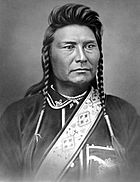
The U.S. Army pursued the Nez Perce for over 1,170 miles (1,880 km) across four states and many mountains. The 250 Nez Perce warriors fought bravely, winning or holding off the soldiers in 18 battles. More than 100 U.S. soldiers and 100 Nez Perce (including women and children) died in these conflicts.
Most of the surviving Nez Perce were finally forced to surrender on October 5, 1877. This happened after the Battle of the Bear Paw Mountains in Montana, just 40 miles (64 km) from the Canadian border. Chief Joseph surrendered to General Oliver Otis Howard. During the surrender, Chief Joseph gave a famous speech: "...Hear me, my chiefs, I am tired. My heart is sick and sad. From where the sun now stands, I will fight no more forever."
The path of the Nez Perce flight is now known as the Nez Perce National Historic Trail.
Nez Perce Horse Breeding
In 1994, the Nez Perce tribe started a special horse breeding program. They crossed the Appaloosa horse with a Central Asian breed called Akhal-Teke. This created a new horse breed called the Nez Perce Horse. The tribe wanted to bring back their traditional horse culture. Horses were a sign of wealth and status, and the Nez Perce were known for their excellent horsemanship.
This program helped restore an important part of their heritage. The Nez Perce Horse is known for its speed.
Current Nez Perce Lands
The Nez Perce Tribe's current lands are on a reservation in North Central Idaho. It is mainly in the Camas Prairie region, south of the Clearwater River. The reservation covers about 1,195 square miles (3,095 square kilometers). In 2000, about 17,959 people lived there.
Because of past land losses, most people living on the reservation today are not Nez Perce. The largest town is Orofino. Lapwai is the center of the tribal government. It has the highest percentage of Nez Perce residents, about 81.4 percent.
In 1895, the U.S. government opened parts of the Nez Perce reservation to non-Native settlers. Thousands of people rushed to claim land, even land owned by Nez Perce families.
The Nez Perce Wallowa Homeland in Wallowa, Oregon, is a special place. It is in the historic territory of the large Wallowa Band. Since 2000, the Homeland has owned 320 acres and a visitor center. Its goal is to "preserve and celebrate the customs and culture of the indigenous inhabitants." In 2021, a Methodist church returned a small piece of land and a church building to the Nez Perce Tribe.
Communities on the Reservation
The Colville Indian Reservation in eastern Washington also includes the Joseph band of Nez Perce.
Famous Nez Perce People
- Chief Lawyer (c. 1796–1876): He was a leader who welcomed Lewis and Clark. He was known for his speaking skills and ability to speak several languages. He signed treaties with the U.S. government, trying to get the best outcome for his people.
- Old Chief Joseph (c. 1785–1871): A leader of the Wallowa Band and an early supporter of peace with white settlers. He was the father of the famous Chief Joseph.
- Chief Joseph (1840–1904): The most well-known Nez Perce leader. He led his people during the Nez Perce War, trying to find a safe home for them.
- Ollokot (1840s–1877): Chief Joseph's younger brother and a war chief. He was killed during the final battle of the Nez Perce War.
- Looking Glass (c. 1832–1877): A leader and war chief who was killed during the final battle with the U.S. Army.
- White Bird (d.1892): A war leader and spiritual guide of the Lamátta band.
- Yellow Wolf (c. 1855–1935): A Nez Perce warrior who fought in many battles during the Nez Perce War of 1877.
- Poker Joe: A warrior and subchief who guided the Nez Perce people after a major battle. He was half French Canadian and half Nez Perce.
- Timothy (1808–1891): A leader of the Alpowai band and one of the first Nez Perce people to become Christian.
- Archie Phinney (1904–1949): A scholar who collected and published Nez Perce myths and legends.
- Elaine Miles: An actress famous for her role in the TV show Northern Exposure.
- Jackson Sundown: A war veteran and rodeo champion.
- Claudia Kauffman: A former state senator in Washington state.
- Michael Wasson: A poet.
-
Chief Lawyer, c. 1861
-
Yellow Wolf, December 30, 1909
See also
 In Spanish: Nez percé para niños
In Spanish: Nez percé para niños


